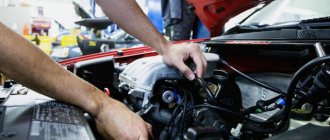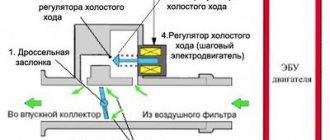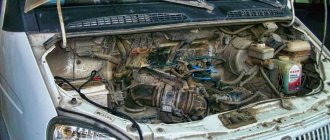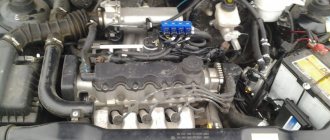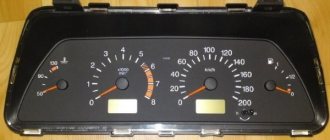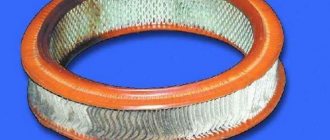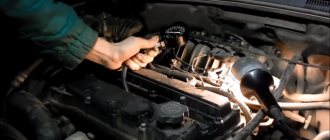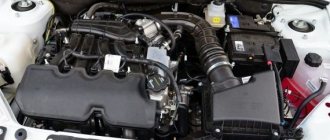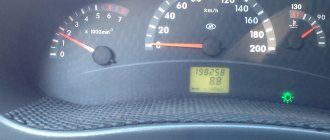When to perform break-in after replacing piston rings
Installing new components into an engine always requires a break-in period. This applies not only to piston rings. It is well known that break-in is required after a major overhaul of the engine, or if the engine is completely new.
The break-in procedure itself implies that the components “grind in” to each other. When replacing piston rings, running-in is required so that they get used to the piston or cylinder. Despite the fact that the dimensions of the parts are standard, they wear out during operation due to a number of technological features. Accordingly, by installing new rings into an engine where old parts remain, complete size matching cannot be achieved. That is, it takes some time to break in the engine so that the parts fit together perfectly.
Mandatory oil changes 4 times
Be sure to use high-quality oil and change it at regular intervals up to four times. Therefore, you should prepare for the cost of oil consumption after a major overhaul.
- First replacement after 500 km running-in.
- 1000 km - second oil change along with the oil filter.
- 1500 km.
- 2 thousand km. — control oil change after major repairs.
All this time, the car should be operated in a gentle mode, for at least three thousand kilometers, and especially not increase the speed in the first thousand.
What types of engine running-in are there?
Proper engine running-in is an important component of success. It is important to understand that there are several types of break-in:
- After major renovation. Run-in after a major overhaul assumes that all engine components need to be ground in, since most of them are changed (usually, after a major overhaul, only the cylinder block and its head remain). That is, in fact, a new engine appears before the driver. It is better to run it in at a service center using special equipment;
- After a partial overhaul of the engine and replacement of some components. This includes running in after replacing the piston rings. This run-in is performed directly on the road. There are rules that need to be followed and these will be discussed below.
It is worth noting that when overhauling an engine in a “garage,” drivers often perform a run-in “in combat conditions,” that is, on the road, without using special equipment. This is not entirely correct and can lead to a decrease in the service life of the motor.
About running in piston rings
Quantity And again about the rings...
I and many people who understand how their equipment works are already accustomed to the fact that “Lukoil is the best oil”, “TTR does not break”, and other nonsense written by incompetent schoolchildren who hardly have the intelligence and resources to maintain the Flintstones' scooter.
But when they write that after replacing the piston rings do not need to be broken in!!!!!! This is already too much!!!
And the most common stupid argument is: “Why run them in? The engine has already been run in!”
Well, let's forget about those who are degrading and return to those who want to know what is right and how it is necessary. Actually, let's move on to my rock painting again.
On a run-in engine, on the cylinder and on the piston rings, a so-called mirror is formed, that is, a perfectly flat and, most importantly, dense contact surface. Hence the compression: when the rings and the cylinder are located tightly to each other, the compression is maximum. Logical.
But between the rings and the cylinder, there is a very thin film of oil (shown in red). It should be evenly spaced, without breaks, and, of course, it should be stable. If you turn the cutoff on a non-run-in engine immediately after starting, the engine will actually be destroyed, because the mirror has not yet formed between the rings and the cylinder, and the oil film will be unstable and will be distributed in clumps, because the new parts (both rings and cylinder) have the smallest roughness , which, in fact, disappear during the running-in process, forming a mirror.
But this is on a new engine, but what about after replacing the rings on a working engine? Yes, basically the same thing, look at the painting.
Actually, the oil film will be distributed throughout your cylinder in such a way that it will be interrupted, erased, in general, your piston will thresh with a huge lack of oil, or, more simply put, dry.
This happens at speeds above average, which is why during break-in it is not recommended to shift beyond 3rd gear, and to drive, for the most part, practically at idle: quietly, peacefully, calmly, in “pensioner” mode.
THE RINGS THEMSELVES SHOULD BE RUN IN FOR A MINIMUM OF 10-15 HOURS!!! Or better yet, 20. Is it possible to have less? Of course you can! You'll just burn the rings and piston!
Bottom line: if you have a modicum of intelligence in you, then break in the rings as required. Yes, it’s a chore, but it’s cheaper than changing the piston, WHICH NEEDS TO BE RUN-IN AGAIN!
pitbikeclub.ru
How long to run an engine after a major overhaul?
How long it takes to run-in after an engine overhaul depends on the test method. An incorrectly carried out test leads to jamming of the motor on the first day. To avoid breakdowns, you need to act carefully and follow the prescribed inspection regime.
On average, the grinding-in of internal combustion engine parts lasts 3000 - 8000 km. You can determine the readiness of the engine by its responsiveness and torque: after pressing the gas pedal, the car cheerfully takes off and confidently accelerates at full speed.
Engine overheating
It is also possible that the engine gets very hot after replacing the rings. Most often this is accompanied by increased vibration.
Possible problems:
- shrinkage of compression rings;
- erasing liners;
- roller wear.
If problems are observed with engine thrust, it is necessary to conduct a superficial diagnosis. The valve seals are inspected; it is important to check the position of the rings. The gaskets must be in place, there should be no large cracks or bulges. The upper liners must be clean without obvious abrasions.
The belt and rollers are also subject to inspection. When replacing rings, you can ask a specialist for more information about the cylinder measurements. There is special equipment for measuring the ellipse of elements. The technician inspects the gaps in the locks. If the engine overheats on a regular basis, the rings will have to be changed urgently.
How to break in after replacing piston rings
Before you begin the break-in procedure, you need to prepare the car. A few steps to follow:
- Charge the battery;
- Before heading out on the road for the first time, first start the engine and wait until it warms up to 80 degrees Celsius. After this, you need to turn it off and wait until the engine cools down to 40 degrees Celsius. Then the engine warms up again to 80 degrees. You need to perform 8-10 such cycles. This is necessary so that preliminary “grinding in” of the parts occurs, caused by their expansion as a result of heating;
- After completing the preliminary step, inspect the car and engine. You need to make sure that there are no leaks of antifreeze, oil or other liquids. If a problem is identified as a result of the inspection, it must be corrected;
- Choose the right section of road to drive. It is better that this is a route with a small number of cars and no elevation changes, that is, it is necessary to exclude entry to and from the slope. You also need to minimize the likelihood of getting stuck in a traffic jam.
Important: The book on technical operation of a specific car model may discuss the issue of engine break-in. Be sure to read and follow the manufacturer's recommendations.
Experts recommend running in the car engine after replacing the piston rings for 1,500 kilometers. The break-in process itself should take place, on average, at 2500 rpm; it is better to do it in third gear. This recommendation will allow you to optimize the process of “grinding in” the rings to the piston and cylinder.
It is better to cover the first 300 kilometers in one ride. A country track is ideal for grinding in. The next 1,200 kilometers must be covered in the same mode, but no matter how many trips, that is, operation can be carried out in a schedule that is comfortable and familiar to the driver.
Important: After traveling 1500 kilometers, it is necessary to replace the oil filter and oil.
(
179
voice, middle:
4,55
out of 5)
Loading…
Running in the engine after replacing rings and bearings
and how labor-intensive this process is.
All the rules noted in the article will help you ensure reliable and efficient operation of the car for a long time.
Moreover, inexperienced, just novice drivers have no idea why a break-in is necessary after any engine repair. Well, in this article I will try to touch on all the important aspects of this issue.
It should be noted that the first stage of engine break-in may not take place in motion, but in place. This will take you 2 or 3 hours.
At the same time, if necessary, adjust the ignition or power systems. Then follows the process of running the engine in motion.
The duration of the process in motion should be at least 2-3 thousand kilometers. However, the user also needs to be aware of the following things:
- When starting the engine for the first time, do not forget to fully charge its battery.
- Warm up the engine before the first trip at idle speed to 80-90 degrees, while making sure that there are no leaks of technical fluids.
- Then, when the engine cools down to 40-50 degrees, warm it up again, and repeat the procedure, if possible, up to 10 times.
- For the first 1000 kilometers, exclude engine operation at high speeds (no more than 3500-4000 rpm) and under high loads (do not transport more than 2-3 people).
- After a (cold) start, it is important to warm up the engine, especially for the first 400-500 km. you should drive along the highway. Thus, you will achieve maximum “working” lapping of the rings and pistons.
- If the traffic occurs mostly in the city, then it is necessary to avoid running the engine at fairly low speeds, i.e. It is advisable not to drive under pressure.
- Find the documents for the car and read the car manufacturer’s recommended speeds for a process such as gear shifting;
- Avoid long climbs.
productive engine running-in after replacing rings
within the recommended 2-3 thousand kilometers, of course, it will require an oil change. Moreover, its quantity must be constantly monitored!
It is also advisable to ensure that the oil filter is also in new condition or do not forget to replace it after break-in.
If necessary, the idle speed and valves are adjusted, and the timing chain is tensioned.
It is important to know that if there are various knocks or other extraneous sounds, you should quickly find their cause.
I would also like to advise drivers not to drive at a certain speed during the break-in process - above 80 km/h for the first 1000 km. and at a speed of 90 km/h for the second 1000-2000 km.
Try to avoid both prolonged and sharp acceleration and prolonged periods of sitting in traffic jams by changing gears in a timely manner.
In general, many experienced motorists and experts advise running in the engine gradually, without loading it. Treat the car as if you just picked it up from the factory.
Run-in is carried out, as a rule, so that the new rings “get used” to the overall system of the car. If the procedure is carried out incorrectly, unpleasant surprises await you.
For example, oil can get into the air purifier, which over time can lead to such drawbacks as quite high fuel consumption, in addition, sometimes problems with starting the car, etc. may arise.
In conclusion, I would like to draw the attention of motorists to the fact that such an event as an effective engine run-in after replacing the rings
is always carried out, and this process is also necessary in cases when a new vehicle is put into operation, or when any repair work has been carried out on the engine.
PS. Proper running-in of the engine after replacing the rings (be careful when using profanity in the story)
Tags: how to properly break in an engine, engine break-in
- Related Posts
- What to fill with antifreeze or antifreeze. What's better?
- Where does antifreeze go from the expansion tank?
- We select antifreeze according to the make of the car. Choice of antifreeze
Methods for running in the engine
You can properly run in the assembled engine after a major overhaul using stands or during operation. At the service station, engine testing takes place in 3 stages:
- cold running;
- hot running without load;
- hot running with load.
The stands allow you not only to run in the engine, but also to check the quality of repairs. To do this, during the test the following is monitored:
- oil and coolant temperature;
- line pressure;
- crankshaft speed;
- developed power;
- specific fuel consumption.
Run-in is considered complete when the parameters reach a certain range of values and the engine is operating properly:
- at idle speed and at maximum shaft speed;
- evenly in all modes, without sudden knocks and noise;
- there are no oil, fuel or coolant leaks through the connections.
Let's take a closer look at how internal combustion engines are tested in service stations and in garage conditions. The methods are equally suitable for both gasoline and diesel engines.
Run-in on the stand
The stands are suitable for both cold and hot running. The equipment is an installation with an electric motor, control and measuring devices and a cardan shaft for transmitting rotation. The equipment is controlled automatically according to a given program.
The stand is selected according to the engine power. After a major overhaul, the motor is mounted on the unit, lubricant and coolant are added, and the necessary pipes and electrical connectors are connected. The test is completed by inspecting the internal combustion engine:
- remove the pallet;
- inspect the main bearing shells and crankshaft journals;
- If necessary, remove the cylinder head and remove the pistons.
Cold running, unlike hot running, is performed at low speeds of the electric motor, not the motor. The test lasts 20 - 40 minutes with a gradual increase in the rotation speed of the electric motor. During the process they control:
- heating the area where the cylinders and main bearings are located by checking by touch;
- tightness of connections;
- uniformity of engine noise;
- oil pressure and temperature.
Similar article Timing marks for 406 ZMZ engine
For example, KamAZ-740 engines are tested according to the following scheme:
| Crankshaft speed, rpm | Mode time, min |
| 600 — 800 | 20 |
| 1000 — 1200 | 15 |
| 1300 — 1400 | 5 |
To reduce the inspection time by 2 times, low-viscosity oils and special additives are added to the internal combustion engine. This technological technique also makes it possible to reduce metal removal from running-in.
Benchless cold running
This option of cold engine running after overhaul is outdated. The car is attached to a tow rope and pulled in 3rd gear for several hours. This method does not allow tracking individual motor parameters and monitoring its condition.
Hot running
Hot running is the most popular method of testing a overhauled engine. It is carried out on a stand or on a machine with or without a load. Before testing on the stand, spark plugs are installed on the engine, the timing gaps are adjusted, and the power and fuel supply systems are connected. Running in the internal combustion engine is accomplished by rotating the crankshaft, so it is important to monitor the parameters of technical fluids.
During hot running without load, the internal combustion engine is started at a reduced crankshaft speed of 800 - 1100 rpm with a smooth increase in speed. The process takes from 20 minutes to several hours and is completed when half the nominal shaft speed is reached.
For example, the mode for engines ZMZ-405, 406 and 409 is as follows:
| Crankshaft speed, rpm | Mode time, min |
| 850 — 1000 | 5 |
| 1400 — 1600 | 5 |
| 1800 — 2000 | 5 |
| 2300 — 2500 | 5 |
The ZIL-645 test is carried out in 8 stages:
| Crankshaft speed, rpm | Mode time, min |
| 1400 | 10 |
| 1500 | 5 |
| 1800 | 5 |
| 2000 | 10 |
| 2200 | 10 |
| 2400 | 10 |
| 2600 | 5 |
| 2800 | 5 |
For running-in under load, the driveshaft of the stand is connected to the flywheel of the internal combustion engine. The electric motor will act as a generator and load the motor at the same time. The test is carried out with a gradual increase in electric motor power and crankshaft speed in accordance with the technical documentation.
For example, YaMZ-238 is checked according to the following scheme:
| Crankshaft speed, rpm | Load, kW | Mode time, min |
| 1500 | 10 | |
| 1600 | 29 | 10 |
| 1700 | 59 | 10 |
| 1800 | 88 | 5 |
| 1900 | 118 | 5 |
| 2000 | 147 | 5 |
Natural engine running-in
Natural or operational running-in is done without a stand and lasts for 2000 - 3000 km. To properly break in the engine after a major overhaul, you must follow the following rules:
- do not pull trailers, avoid slipping;
- keep the motor in the rotation range of 1500 - 4000 rpm;
- do not coast.
Similar article Engine temperature indicator and sensor on Lada Grant
Operational running-in of the engine involves a gradual increase in load:
- for the first 1000 km it is necessary to keep the speed to 3000 min-1;
- increase the next 1000 km to 3500 min-1;
- after 2000 km - up to 4000 rpm.
It is permissible to give a constant load to the engine after 5000 - 8000 km after repair.
Instructions for running in chainsaws
There are two types of break-in procedures, which are carried out on a new tool, and on a chainsaw after a major overhaul of the engine. A new chainsaw needs to be run in with an average load, since idling the engine helps reduce the engine's life. In order not to harm the tool, and at the same time carry out the procedure for grinding in rubbing parts correctly, you should ensure a gentle load on the chainsaw.
Running in the engine of a gas powered tool is carried out in the following way:
1. Setting the supply of the fuel-air mixture in an enriched form. To do this, you will need to adjust the carburetor. The process of starting the unit is described in detail here 2. The carburetor is adjusted by moving the adjusting screws L, H and T 3. Initially, the maximum engine speed is reduced by 600-700 rpm from the maximum value. To reduce the speed, you need to loosen screw H 4 with a slotted screwdriver. To determine the number of revolutions at idle, you need to use a tachometer. How to check the speed of a chainsaw with a tachometer is described here 5. If it is not possible to check the speed with a tachometer, then the adjustment should be carried out according to the instructions. Sawing operators need to purchase a tachometer to measure the speed, since the carburetor will regularly need to be adjusted for normal operation of the unit 6. Without a tachometer, adjustment is made by moving screw H a quarter turn in the rich direction. You can determine the increase in fuel supply by the sound of the engine 7. After completing the break-in stage, you will need to fine-tune the carburetor using a tachometer
During the running-in process, you need to let the unit run for 3-5 minutes at idle, and then start cutting wood with a small diameter of up to 10 cm. Heavy loads on the motor should be avoided, and the sawing process should be accompanied by pauses - 1 minute of work and a 20-second break for XX.
First launch after major overhaul
The first start of the internal combustion engine is carried out according to the following scheme:
- Fill in engine oil. It will take 10 minutes for the lubricant to fill the system. The oil filter is left dry to avoid air lock.
- Connect the fuel pump or supply fuel manually.
- Open the throttle manually if there is no automatic drive.
- Start the starter.
- Spin the motor up to 2000 rpm.
- Leave to idle for 15 minutes until engine rotation becomes stable at operating temperature.
- Turn off the unit and wait for it to cool completely.
Similar article: Correctly changing engine oil in a car engine
During startup, the pressure in the lubrication system is monitored. The indicator signal for 4 s indicates incorrect engine assembly. We urgently need to turn off the engine! If the pressure quickly stabilizes, the internal combustion engine is warmed up to operating temperature.
There should be no leaks upon visual inspection. In the first 3 minutes, the engine may knock: the hydraulic compensators are being pumped or the cups are running in. In the future, the sound should become uniform, without vibration. The appearance of a burning smell and slight smoke for the first start is normal - the assembly lubricants are burning through.
If the internal combustion engine is operating stably, start running-in. In order to properly run in the engine after a major overhaul, you need to understand the nuances of the test.
Engine break-in: rules for proper engine break-in
An internal combustion engine is a rather complex unit that consists of hundreds of different moving parts. During operation, they grind against each other, which reduces additional friction and load on them.
In order for a new engine (or one that has undergone a major overhaul) to operate efficiently, it is necessary that operation be started with this in mind. In other words, it is necessary to observe a certain operating mode for some time (or mileage) after starting a new unit. This special mode of operation is called “running in”.
Break-in is necessary not only for new units. Experienced motorists claim that the engine should be run in even with minimal intervention in its design. For example, when replacing a camshaft or chain. In this case, long running-in is not required. Usually about 500 km of running in gentle mode is sufficient.
After a major overhaul, the engine run-in should be at least 1,500 - 2,000 km, and when replacing cylinder liners and piston rings - all 3,000 - 4,000 km. A special gentle operating mode includes driving at a speed of no more than 50 km/h, a smooth increase in engine speed and limiting the speed to 2,500 rpm.
When replacing piston rings, a certain problem arises due to the fact that they need to be placed in place of piston grooves, which are already quite worn. If the grooves on the piston are badly broken, the new rings can be broken already at the first start of the engine after replacement. How to determine the degree of wear of the groove in this case?
To do this, you should carefully examine the old ring and, first of all, pay attention to its lower surface. A glossy shine with a characteristic “wavy” appearance in sunlight is the main sign that such a piston needs to be replaced, as well as noticeable wear on the groove.
Typically, this increases the slope of the lower surface. Thus, the wear angle of the old ring corresponds to the wear angle of the groove on the piston. If you install a new ring in such a groove, it will usually break during the first start.
It is also characteristic that only the upper (compression) groove with the ring wears out, so wear on the other piston rings is almost not observed. This is exactly what needs to be taken into account when carrying out a break-in after a major overhaul with the replacement of piston rings.
Many manufacturers claim that their engines, fresh off the production line, can be operated at optimal operating conditions. It is necessary to agree that the accuracy of fitting motor parts to each other has indeed become very high, which, however, does not completely eliminate the need to adjust working parts to each other.
Therefore, for a new engine, it is necessary to avoid severe operating conditions, for example, prolonged idling. This, by the way, is mentioned in the operating instructions for almost any car model.
Experts say that the service life of an internal combustion engine without proper running-in is reduced by more than half. In addition, an improperly run-in power unit can lead to other problems and troubles: oil getting into the air cleaner, high fuel consumption, starting problems, etc.
All these arguments convince us of the need for a number of special procedures. For example, when running an engine, it is necessary to change the engine oil. It is believed that 10W-30 oil is most suitable for this.
The oil needs to be changed every 500 km during the break-in process and at least four times completely. Natural brands of oils should be used. In addition, before the first start, it is necessary to check the quality of the tightness of the threaded connections, adjust the valve clearances, belt (chain) tension, gas distribution mechanism drive and replace the oil filter.
With the commissioning of a new power unit or engine after a major overhaul, it is necessary to carry out a three-hour cold run-in, during which the operation of other systems (ignition and power supply) can be finally adjusted.
Naturally, in addition to changing the oil and cold running-in, it is necessary to follow some driving rules, avoiding excessive load on the power unit. To do this, it is necessary to avoid driving at high speeds, overloading the car with passengers or cargo, sharply slowing down, and driving for long periods in low gears.
Another important condition is compliance with the speed limit. As mentioned above, the gentle mode is considered to be driving at a speed of no more than 50 km/h. Although with new engines, the first 300 - 400 kilometers can accelerate to 80 km/h. The main thing is that the movement be as uniform as possible, without switching to lower gears.
In practice, this is not difficult to accomplish by running along an unloaded country road at night without significant ups and downs. After the first 300 - 400 km, the speed can be gradually increased. The main thing is that the operating mode approaches the optimal one as smoothly as possible and the speed of movement remains as constant as possible.
Why does the engine eat oil?
Sometimes, after replacing the oil scraper rings, grease continues to be wasted unnecessarily. In this case, the reason is probably not only in the rings. This usually happens when there are problems with valve stem seals.
This part can be found on the valves. They remove excess lubricant from them and prevent it from entering the combustion chamber. It is recommended to immediately replace the caps during any engine overhaul so as not to disassemble the engine twice.
Article on the topic “Why the engine eats oil but does not smoke.”
Conclusion
. Sooner or later the engine has to be repaired. In this case, running in the engine after replacing the piston rings is simply necessary. This work must be done correctly in order to significantly increase the service life of the repaired unit.
see also
Comments 27
if the pistons are old (that is, there has been no major repairs), then 500 km is enough, and then at least until the cutoff!
and I still couldn’t get through the break-in after replacing the rings... T__T
and how does it feel without running in? how far have you run?
who the hell knows) I’ll never get around to measuring the compression) 7-8 thousand
how does it feel? and how long did it take for it to start to pile on?
I didn’t have enough patience) and the carbs at that time were not yet properly tuned, they drove normally only after 3k revolutions
okay) I just changed the rings and head on mine, in about 20 minutes I’ll do the first launch and, as luck would have it, I have to go straight to the highway and head to another city. I’m wondering how long I’ll last)))
Well, I think 90 is not too hard to go without overtaking and it will be fine
I will try. ok let's go finish it
I replaced the rings on mine, drove about 500 km, changed the oil, now I drive in normal mode, rev the engine to 3.5 in every gear, at first there were overtones after 3000, now everything has returned to normal, the sounds are gone, the car drives boldly, cheerfully...
Oil selection and frequency of replacement
It is worth considering in more detail the issue of replacing lubricating consumables after a power plant overhaul. First, this must be done after 500 km. Then after 1000 and the last time after 2000 km. Use high-quality motor oil recommended by the manufacturer. After the specified kilometers have been covered, drain the used mixture and flush the engine. When running in, take into account the oil viscosity:
- in summer 15W40;
- in winter 5W30;
- in the intermediate season: 10
